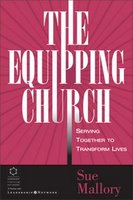Pastor led churches often struggle with how to most effectively utilize the time and talents of their pastoral staff without creating burn-out and rapid clergy turnover. Sue Mallory’s book The Equipping Church (Grand Rapids: Zondervan, 2001) has provided a biblical sound option for churches in search of finding the right balance between pastor/ teacher and pastor/ burnout.

The Equipping Church is by far the most practical and useful book I have read relating to lay leader church development. This book is written in lay language but supplies ample theological insights to support the development of a lay driven church. Mallory provides insights into the purpose, process, implementation and quality revisions of starting a lay leader driven church. The contents of this book are ordered in a way that takes the reader from initial purpose and buy-in, from congregation and pastoral leadership, through refining church vision. Mallory’s vision of a lay leader driven church has translated to an immense following of church’s that are now driven by the model based on Ephesians 4:11-13.
What is especially useful is how Mallory takes the reader not only through the equipping process but relates her own experiences and struggles, as well as other equipping model churches experiences, in providing the template for an equipping church that she has created. These experiences include not only successes but also failures and pitfalls that leaders moving to an equipping model need to be aware of to implement this way of being church. This book does not provide a pie in the sky version of how every church will immediately see drastically new positive changes in their congregation if they only follow these simple steps. Instead she makes it abundantly clear that there will be challenges in implementing this new process and that leaders must enter into this program with a sense of clarity and determined purpose before attempting to implement the strategies she lays out in the book.
The Equipping Church is extremely easy to read and understand theologically. I do, however, feel that there could be more instruction provided to the existing pastor to understand better his role in the equipping church model. Mallory gives basic instruction as to the need and benefits of creating an equipping church, but I feel that a pastor reading this book that has been in the drivers seat of a traditional church may need some better clarity as to his or her new responsibilities. Removing responsibility sounds like a wonderful concept, that most pastors would welcome, but how does the pastor translate this newly found freedom into his current position without feeling uneasy about the responsibilities that are no longer his main emphasis?
Another area in which I feel could be expanded on in The Equipping Church is the maintenance phase of the equipping church. Mallory did provide some useful insight into continuing the vision, but like most church programs; if it does not remain fresh and new the passion of the congregation for the program will dwindle.
Overall I feel that this is a wonderful book and that all church leaders would benefit from at least reading about the equipping church model. Mallory provides some insightful realities about the struggles of churches that look to paid staff members to accomplish the bulk of the church’s missions.
Reviewed by guest blogger David Clark
